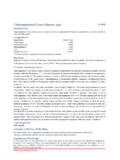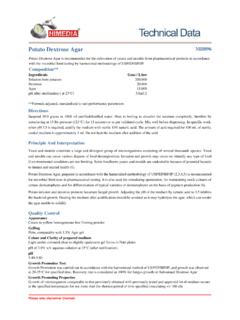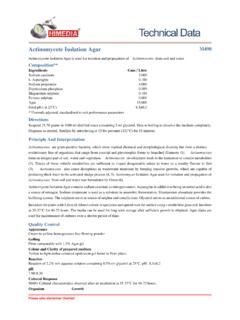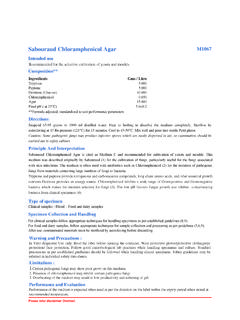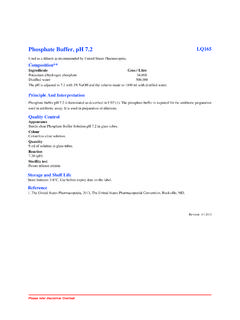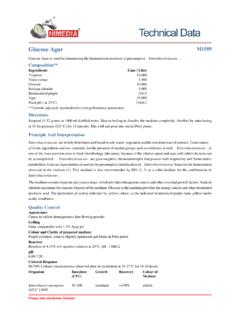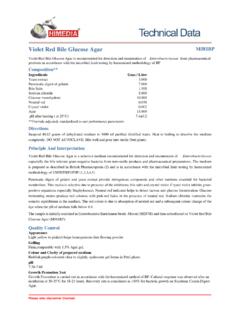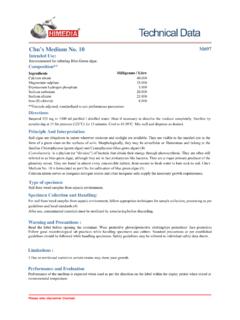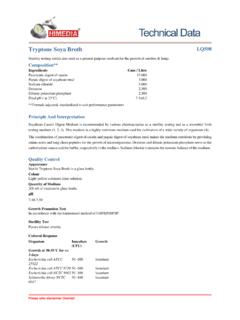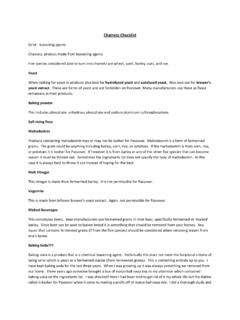Transcription of MY 40 Agar (Osmophilic Agar) - HiMedia Labs
1 MY 40 agar ( osmophilic agar ) M594. MY 40 agar ( osmophilic agar ) is used for detection and isolation of osmophilic microorganisms from food samples. Composition**. Ingredients Gms / Litre Malt extract Yeast extract Sucrose agar **Formula adjusted, standardized to suit performance parameters Directions Suspend grams in 100 ml distilled water. Heat to boiling to dissolve the medium completely. Sterilize by autoclaving at 15 lbs pressure (121 C) for 15 minutes. DO NOT OVERHEAT. Mix well and pour into sterile Petri plates. Principle And Interpretation osmophilic yeasts usually are the cause of spoilage of high-sugar foods, including jams, honey, concentrated fruit juices, chocolate candy with soft centres etc. (1, 2). osmophilic yeasts are of no public health significance, but are of economic importance to the food industry (2).
2 A simple presence-absence test for detection of small numbers of osmotolerant yeasts in high-sugar foods is useful for enumeration. osmophilic agar (MY 40 agar ) is generally used for this purpose. Walker and Ayers (3) in their review have differentiated between osmophilic yeasts and osmoduric yeasts. Almost all of the known osmophilic yeasts are Saccharomyces species Saccharomyces rouxii, var. polymorphus, Saccharomyces mellis etc. Improved recovery of osmophillic yeasts has been reported on media, which resemble the composition of the food under examination or contain high sugar concentrations (4). osmophilic agar is recommended for cultivation of a wide variety of osmophilic organisms (5). MY in MY-40 agar stands for malt extract and yeast extract and 40 for the 40% of sucrose in the medium, which meets the above requirements.
3 The medium contains malt extract and yeast extract which supply the nitrogenous nutrients, amino acids, vitamins, trace ingredients to the osmophilic yeasts. 40% sucrose in the medium satisfy the nutritional need of these yeasts. Quality Control Appearance Off-white to yellow homogeneous free flowing powder Gelling Firm, comparable with agar gel. Colour and Clarity of prepared medium Medium amber coloured slightly opalescent gel forms in Petri plates Cultural Response M594: Cultural characteristics observed after an incubation at 25-30 C for upto 1 week. Organism Growth Cultural Response *Aspergillus brasiliensis good-luxuriant ATCC 16404. Mucor racemosus ATCC good-luxuriant 22365. Pencillium notatum ATCC good-luxuriant 10108. Saccharomyces rouxii ATCC good-luxuriant 28253. Please refer disclaimer Overleaf.
4 HiMedia Laboratories Technical Data Storage and Shelf Life Store below 30 C in tightly closed container and the prepared medium at 2 - 8 C. Use before expiry date on the label. Reference 1. Rose A. H. and Harrison J. S., (Eds.), 1970, The Yeasts, Vol. 3, Academic Press, New York. 2. Tilbury R. H., 1980, "Biology and Activities of Yeasts", Skinner and others (Ed.), Academic Press, London. 3. Walker , and Ayers , 1970, Jn. Rose and Harrison (Eds.), `The Yeasts', Vol. 3, Academic Press, Inc., New York. 4. Anand and Brown , 1968, J. Gen. Microbiol., 52:205. 5. Atlas R. M., 2004, Handbook of Microbiological Media, Lawrence C. Parks (Ed.), 3rd Edition, CRC Press. Revision : 2 / 2015. Disclaimer : User must ensure suitability of the product(s) in their application prior to use. Products conform solely to the information contained in this and other related HiMedia publications.
5 The information contained in this publication is based on our research and development work and is to the best of our knowledge true and accurate. HiMedia Laboratories Pvt Ltd reserves the right to make changes to specifications and information related to the products at any time. Products are not intended for human or animal or therapeutic use but for laboratory,diagnostic, research or further manufacturing use only, unless otherwise specified. Statements contained herein should not be considered as a warranty of any kind, expressed or implied, and no liability is accepted for infringement of any patents. HiMedia Laboratories Pvt. Ltd. A-516,Swastik Disha Business Park,Via Vadhani Ind. Est., LBS Marg, Mumbai-400086, India. Customer care No.: 022-6147. 1919 Email.
